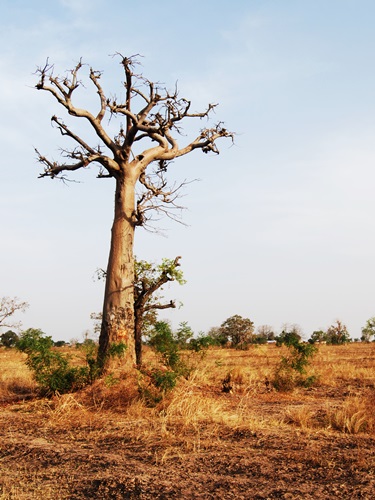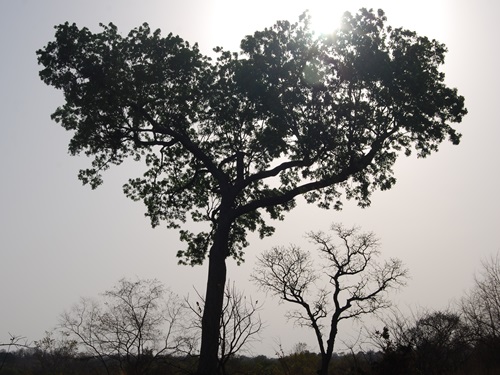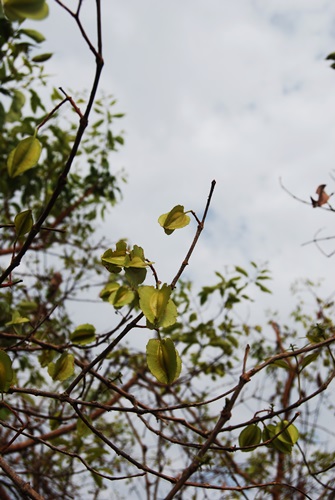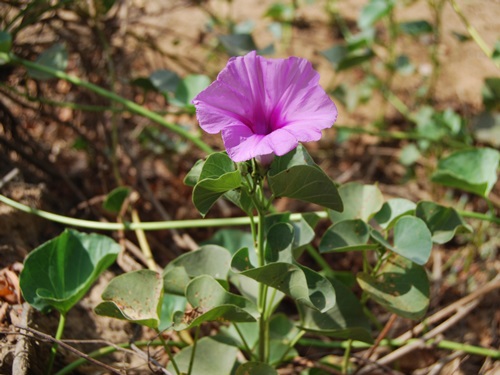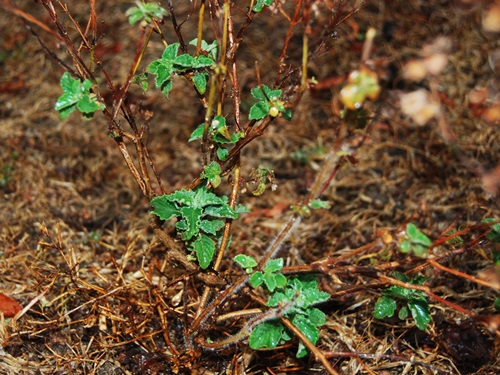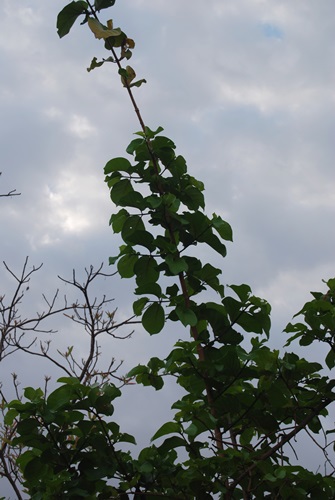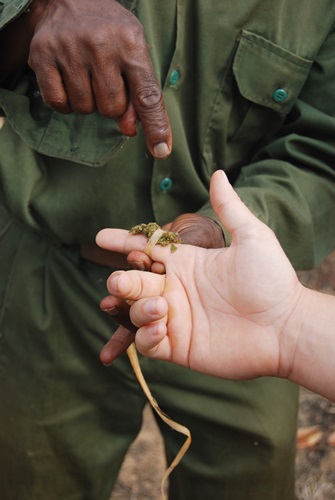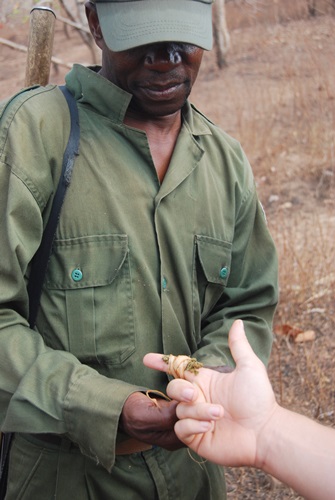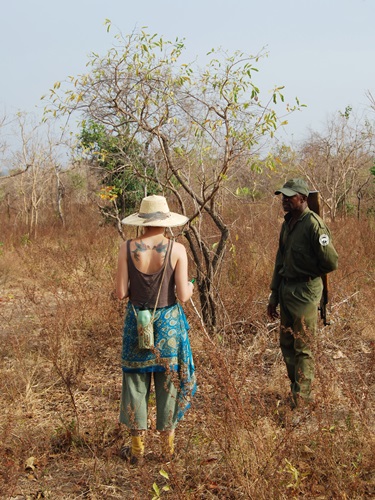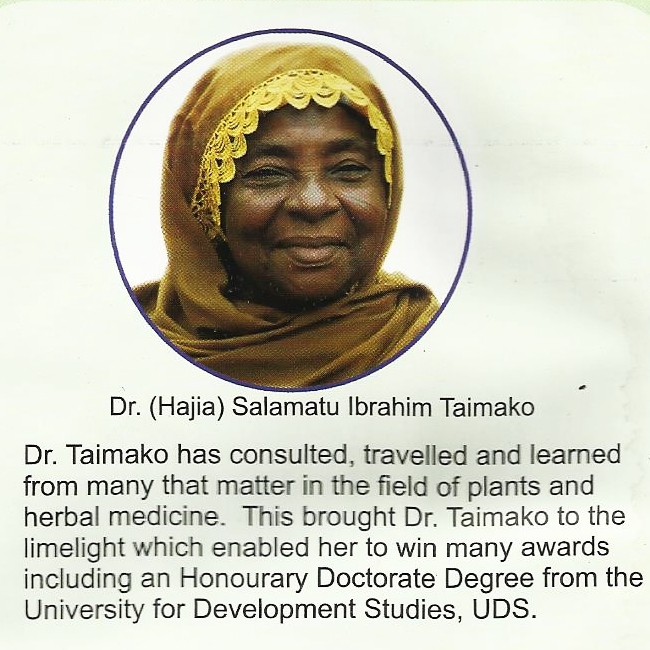Our trip to the Northern Region was full of wonderful plant encounters.
STATELY TREES
The few tall trees of the Savanna are striking indeed. These two majesties are heralded for their medicine and energy. On the left, a baobab (Adansonia digitata, Malvaceae) shines in the morning light across from the Asempa Lodge. The African mahogany (Khaya senegalensis, Meliaceae) on the right was a helpful landmark when we were out on walking safaris in Mole National Park.
DAWA DAWA


This was one of the first trees that caught our eye in the north with its bright, round pinkish red inflorescence and long seed pods. After asking around, we later learned of the important economic and food purposes of this tree for many animals. To Amy’s delight we also finally were introduced to the tree by its scientific name, Parkia biglobosa, a member of the Fabaceae family. Humans make a flour from the inside of the seed pod after drying and fermenting the starchy, golden interior. The food is known as dawa dawa and is the reasoning for the local common name of this tree. It is used to prepare pancakes and porridge, adding sweetness to many dishes. The monkey on the right was busy harvesting its favorite treat from the tree- sucking the fluids from the nodes where the pods emerged.
KNOWLEDGEABLE GUIDES


Each of our guides in the park were very knowledgeable and passionate. Once they learned of Amy’s interest in traditional and medicinal uses of the plants they readily shared their stories of usage among their native villages. They were also excellent at recalling the scientific names of the flora which was especially delightful for Amy.
TAKING A CLOSER LOOK
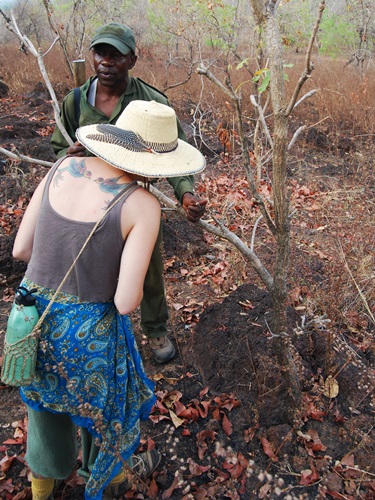

Amy leans in to see the milky sap emerge from the knobby limb of this shea tree (Vitellaria paradoxa, Sapotaceae). This sap has been traditionally used for snakebites, sometimes even helping to remove the tooth from the wound. This is also the tree that yields the nuts which are processed into shea butter, an important economic tree for many local villages. To read more about our trip to a shea butter processing village, see the Mbanayili page. Jeremy shakes the prickly hand of a tree commonly in the park called “wait a minute” tree (Ziziphus mauritiana, Rhamnaceae) since it will snag your clothing with its stipular spines. It yields an edible fruit high in vitamin C.
EYE CATCHING FLOWERS AND FRUIT
Visiting the park in the dry season is ideal for elephant and wildlife spotting, but not so much for meeting the plants. The yellow flowers belong to an African laburnum (Cassia sieberiana, Fabaceae) one of the few trees that flower at the end of the dry season, the showy inflouresence surely stood out in the dry Savanna, catching Amy’s eye for a nice photo op while the others were bird watching. This tree has many medicinal uses, although none of our guides recalled any specifics. Most trees and herbs were in various stages of fruit and seed. The photo on the right shows a type of bushwillow, (Combretum sp., Combretaceae) we learned that these four winged fruits are a clear indicator of the Combretum genus, which is widely speciated and common in the park.
A FEW FLOWERING HERBS
We were only able to see few herbs in flower, and they were easily spotted along the dry Savanna floor. The irregular shaped flower on the left belongs to a species of rattlepod (Crotalaria sp., Fabaceae) which was quite common, although most individuals we saw were already making fruit. When dried, the seed pods make a nice shaker toy for the local village children. The radially symmetrical flower to the right is a type of morning glory (Ipomoea sp., Convolvulaceae) which was growing on the edge of the watering hole. Amy tried to narrow these plants down to their species, but really can’t have positive ID using only the internet and these photos. (It’s hard to focus on taking notes of plant parts when there are frolicking elephants nearby.)
NEW GROWTH
As the rainy season approaches, the plants are shooting out precious new growth. The first photo shows wild mint (Mentha sp., Lamiaceae) right after a rainstorm which was prolific in the park, emitting its wonderful aroma as we navigated through last year’s dried stalks and seed heads. We seemed to be just too late for gathering some native mint seeds, Bob has tried propagating mint from the market and it hasn’t quite taken, bizarre for a usually prolific plant. The beautiful new growth in the second photo belongs to an African ebony (Diospyros mespiliformis, Ebenaceae). These trees are common in the park and bear fruit enjoyed by monkeys, humans, elephants, and other wildlife. The wild persimmon of the US is a close relative in the same genus (D. virginiana).
FOR INDIGESTION..
This shrub,(Nauclea latifolia, Rubiaceae) is common throughout the park. Locally, the bitter inner portion of the bark and root bark are traditionally steeped and taken for a grumbling digestive tract. Our guides noted that they still use this plant often, keeping dried bark with them for use when needed. The first photo shows the new growth of this helpful plant happily glistening with raindrops after the first storm of the year, which we were able to experience out on the Savanna floor on our second day in the park.
We found it interesting that although this species of Nauclea doesn’t have its own wikipedia page, there has been a lot of research done on the medicinal properties of N. latifolia, especially in the treatment of malaria and diabetes.
“ANTIBIOTIC TREE”
This powerful tree, (Piliostigma thonningii, Fabaceae) was a group favorite as we learned of its many uses and met it over and over throughout the park. On this day, our guide Zach from the Gonja tribe shared that traditionally they use the tea made from the leaves as and antiseptic wash after the traditional scarification of babies on their eighth day of life, also the day that they receive their name. He assured that this kept the new cuts from infection, easing the worries of the new mother. In the second photo, Zach shows us how he harvests the bark for the use of the fiber.
FIRST AID SUPERSTAR
Using the bark fibers, Zach shows us how he would dress a cut using Piliostigma. He crushed the fresh leaves of the newest growth in the palm of his hand, forming an antiseptic poultice. He then tied the poultice onto Jeremy’s finger with the bark fiber. Apparently this will keep the wound from infection and would even keep the cut fresh and stitch-able after a few days.
IN HER ELEMENT
Amy really enjoyed learning more about the local plants from each guide, and was even getting tested by Zach by the third day of walking safaris. She was truly in her element, making new plant friends in the Savanna.
WHAT IS THAT?!


Bob spotted these plants from the car window on our bumpy ride back to Tamale from Mole. We had to pull over and get a closer look. After some internet investigation, he identified them as Amorphophallus dracontioides, Araceae. They were common along the roadside that day, perhaps emerging after the first rains.
TAIMAKO HERBAL CENTRE
Our plant adventure continued; upon returning to Tamale, we sought out the Taimako Herbal Centre. We were greeted by Faiza Taimako, the current director of the centre that was founded by her mother, Dr. Hajia Salamatu Ibrahim Taimako. They were incredibly welcoming, inviting us into their home and spending plenty of time speaking with us about the many facets of their business. The centre boasts a large native medicinal plant nursery and farm, north of Tamale near Savelugu. They are doing wonderful work; enriching the land with native medicinal plants and fruit trees, enriching the lives of youger generations as they keep important traditional knowledge alive, and certainly enriching the local community with their selfless nature of healing. Here is an article we found with a bit more information and history of the centre.
___________________________________________________________
[Latest] * [Troutsfarm] * [Green Ranch] * [FS2BD February] * [Journey to Asempa] * [Mole National Park] * [First Two Safaris] * [Final Safari] * [Meeting Savannah Plants] * [Mbanayili Village] * [ Tamale]
____________________________________________________________
